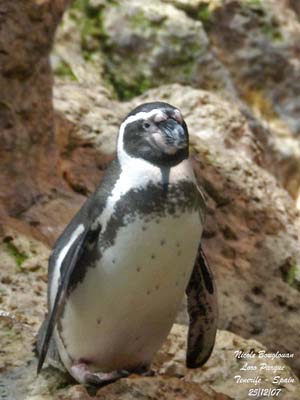
Humboldt Penguin
Spheniscus humboldti
Sphenisciforme Order – Spheniscidae Family
BIOMETRICS:
Length : 65 à 70 cm
Weight : 4 à 4,7 kg
LONGEVITY: Up to26 years
DESCRIPTION:
Humboldt Penguin is a South American medium-sized penguin. Its name comes from Alexander von Humboldt, naturalist and explorer, who described this penguin. And this species lives along coasts bordered by the Humboldt Current.
Fr : Manchot de Humboldt
All : Humboldtpinguin
Esp : Pingüino de Humboldt
Ital : Pinguino di Humboldt
Nd : Humboldtpinguïn
Text and photographs by Nicole Bouglouan
Sources:
HANDBOOK OF THE BIRDS OF THE WORLD vol 1 by Josep del Hoyo-Andrew Elliot-Jordi Sargatal - Lynx Edicions - ISBN: 8487334105
Antarctic Connection (Thomas Hutchings – Gloria Hutchings)
Les Manchots (François Durand)
Welcome to the wonderful world of penguins (Dr. Lloyd Davis)
Wikipedia (Wikipedia, The Free Encyclopedia)


Adult has blackish upperparts, including flippers and short tail. It has stiff feathers which overlap, in order to waterproof and insulate the body.
Underparts are white, with conspicuous broad black stripe across the breast, extending downwards to the flanks, and ending in fine black line around the thighs.
Throat is black, extending to the head sides, up to the eyes. Upper breast is white, extending downwards to the breast, sides and flanks, surrounding the flippers’ bases and ending on the thighs. Some small black spots are scattered through white belly and vent. Under flippers are black and white.

On the head, forehead, crown, nape, cheeks and ear-coverts area are black. A white stripe from lores to ear coverts joins the white breast sides, forming a conspicuous supercilium.
Thick, short bill is black, with broad pinkish area at base and around the eyes, becoming white in some individuals. Eyes are pale brown. Strong legs and webbed feet are black.
Both sexes are similar, with female slightly smaller than male.
Juvenile has grey head and lacks the black band across the breast. Head pattern is duller and indistinct. It reaches its sexual maturity at 2 to 3 years.
VOICE: SOUNDS BY XENO-CANTO
Humboldt Penguin uses contact, display and alarm calls. Mates recognize one another by combination of vocalises and sight.
HABITAT:
Humboldt Penguin lives and breeds on rocky mainland coasts, and prefers areas with cliffs. It can also breed on islands off the coasts.
RANGE:
Humboldt Penguin lives and breeds on Peru and Chile coasts, along Humboldt’s Current. It does not migrate.

BEHAVIOUR:
Humboldt Penguin feeds mainly on fish such as anchovies of about 10 to 15 cm length. It also takes squid. It fishes in groups, in order to gather great numbers of anchovies and to catch them. This species has excellent eyesight as underwater or on land.
It catches preys by swimming underneath the shoal, and disturbs them, making easier their capture. They usually fish near the shores with other species of birds and mammals in cold currents.
Humboldt Penguin is very gregarious and lives in large colonies where they frequently communicate. It walks on land with clumsy gait, but it “flies” underwater, thanks to its flippers which make it very agile and fast swimmer.

During the breeding season, both mates perform mutual preening which strengthens the pair-bonds.
Humboldt Penguins nest in burrows, and their chicks remain in it until they fledge. Crèches are not used as in species nesting in surface.
Burrows situated close to the water can be sometimes flooded by waves and storms.
They reuse the same nest-site year after year.
Humboldt Penguin is resident with some movements, according to the food resources.
MOVEMENTS:
Humboldt Penguin does not fly, but it uses its relatively long flippers for “flying” underwater, just below the surface. It is able to reach speeds up to 30 km per hour. It steers its body with help of feet and tail.

REPRODUCTION:
Humboldt Penguin breeds at any time of the year. Reproduction depends on food resources. They nest in colonies.
This species breeds in burrows situated in caves, crevices, holes in rocks, but also in open rocky shores. The burrow is made with help of flippers and feet to push and remove the sand. They can add stones and grass.
Several years ago, the burrows were situated in the guano, in offshore islands. But the guano’s exploitation removed it and penguins had to establish their nests in other places.

Female usually lays 2 eggs, at 2 to 4 days interval. Incubation is shared by both parents during about 39 to 43 days. They take turns regularly, in order to forage between two stints.
Once chick hatched, one of the adults remains at nest with it, while the other hunts for food.
But when the young is two months old, it is left alone during the day, and parents forage together up to 35 km from the nest-site.
The moult of the young occurs between 70 to 90 days of age. At this time, down is replaced by grey feathers, becoming darker little by little.
This species can produce two broods per season, according to the food availability and weather conditions.
DIET:
Humboldt Penguin feeds on fish (anchovy), squid and crustaceans. It forages at about 60 metres depth, usually less, but some observations at 150 metres depth occurred. It searches for food among water weeds.

PROTECTION/THREATS/STATUS:
Humboldt Penguin is caught in fishermen nets, and great numbers disappear every year. They are killed for food, and eggs are taken, resulting in disturbances at breeding colonies.
In addition, breeding areas are damaged by human activities and the guano disappeared.
Predators such as cats and dogs disturb nesting areas. Natural predators such as gulls, raptors, foxes and cetaceans attack young and adults.
And finally, over fishing of anchovy reduces available food for Humboldt Penguin.
Their populations are declining, and the status of this species is Vulnerable.